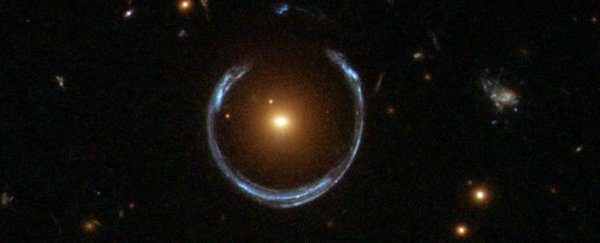Gravitational lensing is a curious phenomenon. Not only does it demonstrate properties associated with the invisible dark matter, gravitational lensing is a distortion or bending of spacetime that was one of the predictions in Einstein's general theory of relativity.
Due to their uniqueness and what they can tell us about the universe, astronomers continue to study images showing gravitational lensing. To do this faster, researchers may turn to artificial intelligence (AI).
"Analyses that typically take weeks to months to complete, that require the input of experts and that are computationally demanding, can be done by neural nets within a fraction of a second, in a fully automated way and, in principle, on a cell phone's computer chip," postdoctoral fellow Laurence Perreault Levasseur said in a press release.

Levasseur is a co-author of a study published in Nature that discusses the work of a team from the Kavli Institute for Particle Astrophysics and Cosmology (KIPAC), a joint effort by the US Department of Energy's SLAC National Accelerator Laboratory and Stanford University.
The researchers used an artificial neural network trained by being exposed for almost a day to half a million simulated images of gravitational lenses.
These were then shown actual images of new gravitational lenses, and it was able to analyse the distortions 10 million times faster than traditional methods.
This is significant because while the traditional method weeks or a month just to analyse one lens using computer simulations and mathematical models, the same can be done by AI in less than half a second.
"The amazing thing is that neural networks learn by themselves what features to look for," co-author and KIPAC staff scientist Phil Marshall said.
"This is comparable to the way small children learn to recognise objects. You don't tell them exactly what a dog is; you just show them pictures of dogs."
Gravitational lensing occurs when light from an observed distant source bends or appears distorted because of some distribution of matter, usually galaxy clusters, between the source and Earth.
This lensing or distortion of spacetime gives us clues about how mass can be distributed in space, which also changes over time.
The SLAC study isn't the first time researchers have turned to AI to study gravitational lensing. Previous works included having a neural network identify if an image showed gravitational lensing or not.
The new study went beyond this.
"The neural networks we tested – three publicly available neural nets and one that we developed ourselves – were able to determine the properties of each lens, including how its mass was distributed and how much it magnified the image of the background galaxy," lead author Yashar Hezaveh explained in the press release.
Interestingly, the researchers also used the same neural networks to figure out the uncertainties of their study. They published this second paper in the Astrophysical Journal Letters.
There's no doubt that AI systems are trained to do things better than humans do, be it in ancient boardgames or modern video games. In becoming better than us in certain tasks, AI can help us do a number of things better - whether it be in driving cars or in facilitating various fields of research.
This article was originally published by Futurism. Read the original article.
